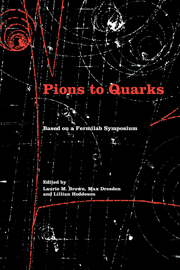Book contents
- Frontmatter
- Contents
- List of contributors
- Foreword by Leon M. Lederman
- Editors' acknowledgments
- Photographs of the symposium
- List of abbreviations
- List of notation
- I Introduction
- II Particle discoveries in cosmic rays
- III High-energy nuclear physics
- IV The new laboratory
- V The strange particles
- VI Weak interactions
- 24 Detection of the neutrino
- 25 Recollections on the establishment of the weak-interaction notion
- 26 Symmetry and conservation laws in particle physics in the fifties
- 27 A connection between the strong and weak interactions
- 28 The weak interactions from 1950 to 1960: a quantitative bibliometric study of the formation of a field
- VII Weak interactions and parity nonconservation
- VIII The particle physics community
- IX Theories of hadrons
- X Personal overviews
- Name index
- Subject index
28 - The weak interactions from 1950 to 1960: a quantitative bibliometric study of the formation of a field
Published online by Cambridge University Press: 07 May 2010
- Frontmatter
- Contents
- List of contributors
- Foreword by Leon M. Lederman
- Editors' acknowledgments
- Photographs of the symposium
- List of abbreviations
- List of notation
- I Introduction
- II Particle discoveries in cosmic rays
- III High-energy nuclear physics
- IV The new laboratory
- V The strange particles
- VI Weak interactions
- 24 Detection of the neutrino
- 25 Recollections on the establishment of the weak-interaction notion
- 26 Symmetry and conservation laws in particle physics in the fifties
- 27 A connection between the strong and weak interactions
- 28 The weak interactions from 1950 to 1960: a quantitative bibliometric study of the formation of a field
- VII Weak interactions and parity nonconservation
- VIII The particle physics community
- IX Theories of hadrons
- X Personal overviews
- Name index
- Subject index
Summary
Background and introduction
About ten years ago, a group of sociologists and scientists gathered at Cornell University in a new program of research designed to discover and validate new methods for studying the evolution and health of scientific fields using quantitative measures. The interests of the group's founders lay both in finding ways to obtain a better basic understanding of how scientific fields develop – how, for example, the social and intellectual aspects of a scientific community interact – and in producing work that might have an influence on the way in which science policy is formulated by showing policy analysts better ways of monitoring the outputs of science and relating them to the inputs.
We believed that the best way to proceed with this program was to undertake several case studies of scientific specialties using teams of collaborators made up of sociologists and scientists familiar. with the specialties in question. We believed, further, that one case study should focus on a field with a strong and highly developed theoretical basis that also involved major experimental work. That meant a field like particle physics, and we thought that within particle physics the study of the weak interactions might be a manageable specialty on which to focus.
A large and comprehensive data base was constructed, comprised of all serial articles published in the specialty from 1950 to 1975 (N = 5,765), and our own weak-interactions citation index was constructed from the refer ences that appear at the end of the serial articles. Over 80,000 references, originating in one of the articles in our weak-interactions bibliography (citing articles both within our bibliography and in other fields), make up our citation index.
- Type
- Chapter
- Information
- Pions to QuarksParticle Physics in the 1950s, pp. 390 - 406Publisher: Cambridge University PressPrint publication year: 1989
- 1
- Cited by



